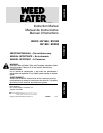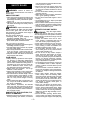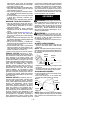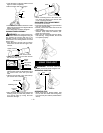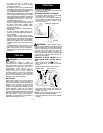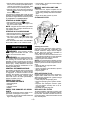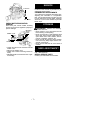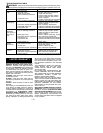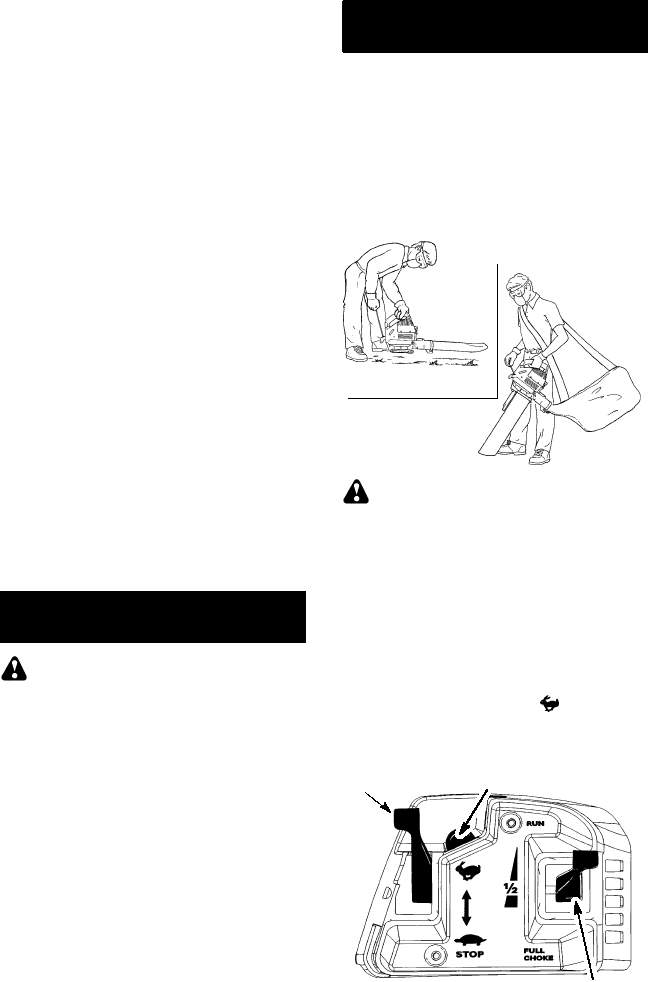
-- 5 --
S
To reduce the risk of hearing loss
associated with sound level(s), hearing
protection is required.
S
To reduce the r isk of injury associated with
contacting rotating parts, s top the engine be-
fore installing or r e m o v in g attac h ments. D o
not oper ate without guard( s) in place.
S
Operate power equi pmentonly atreasonable
hours--not earlyin the morning orlate at night
whenpeople m ightbe di sturbed.Complywith
times listedin localordinances. Usualrecom-
mendations are 9:00 a .m. to 5:00 p.m.,
Monday though Saturday.
S
To reduce noise levels, limit the number of
pieces of equipment used at any one time.
S
To reduce noise levels, operate power
blowers at the lowest possible throttle
speed to do the job.
S
Use r akes andbrooms to loosen debris be-
fore blowing.
S
In dusty conditions, slightly dampen sur-
faces or use amister attachment when wa-
ter is available.
S
Conserve water by using power blow er s
instead of hoses for many lawn and garden
applications, including areas such asgutters,
screens, patios, grills, por ches, and gardens.
S
Watchout f orchildren, pets, openwindows,
or freshly washed cars. Blow debris away
safely.
S
Use the full blower nozzle extension so the
air stream can work close to the ground.
S
After using blowers and other equipment,
CLEAN UP! Dispose of debris in trash re-
ceptacles.
FUELING
WARNING:
Remove fuel cap slowly
when refueling.
This engine is certified to operate on
unleaded gasoline. Gasoline must be mixed
with agood quality 2--cycle air--cooled engine
oil designed to be mixed at a ratio of 40:1.
Poulan/Weed Eater brand oil is
recommended. (A 40:1 ratio is obtained by
mixing 3.2 ounces of oil with 1 gallon of
unleaded gasoline). When mixing fuel follow
the instructions printed on the container.
Always read andfollow thesafety rules under
HANDLE FUEL WITH CAUTION.
IMPORTANT
Experience indicates that alcohol blended
fuels (called gasohol or using ethanol or
methanol) canattract moisture which leads to
separation and formation of acids during
storage. Acidic gas can damage the fuel
systemofanengine while instorage. Toavoid
engine problems, empty the fuel system
before storage for30days orlonger. Drainthe
gastank, start theengine andlet itrununtil the
fuel lines andcarburetor are empty. Usefresh
fuel next season. Nev er use engine or
carburetor cleaner products in the fuel tank or
permanent damage may occur .
STARTING
TO STOP THE ENGINE
D
To stop the engine, move the throttle lever
to the STOP position.
BEFORE STARTING THE ENGINE
D
Fuel engine. Move at least 10 feet (3 me-
ters) away from the fueling site.
D
Hold the unit in the starting position as
shown. Make sure the blower end is di-
rected away from people, animals, glass,
and solid objects.
Blower
Vacuum
STARTING POSITION
WARNING:
When starting engi ne,
holdtheunit asillustra te d.Don otsetunitonany
surfaceexcept a clean, hardarea w henstarting
engine or while engine is running. Debris such
as gr avel, s and, dust, gr ass, etc. coul d be
picked up by the air intake and thrown out
through the discharge opening, damaging the
unit or property, or causing ser ious injury to by-
standers or the operator.
STARTING A COLD ENGINE (or a
warm engine after running out of
fuel)
S
Move throttle lever to the
position.
S
Move choke lever to the FULL CHOKE
position.
S
Slowly press the primer button 8 times.
Throttle Lever
Choke Lever
Primer Button
S
Pull starter rope sharply until engine at-
tempts to run, but no more than 5 pulls (be-
low 30
_
F, 8 pulls).
NOTE:
If engine attempts to start before the
5
th
pull, go to next step immediately.
S
Move the choke lever to the HALF CHOKE
position.



